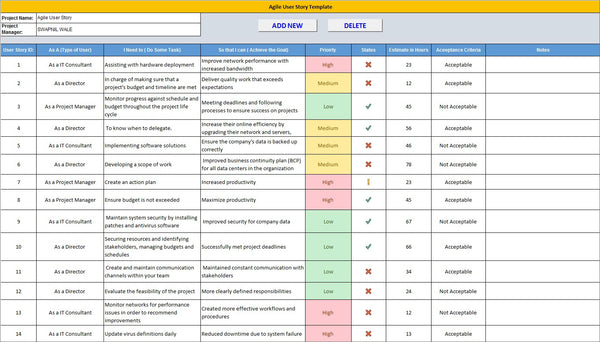User Story For Agile Development Projects
User stories are a way for product managers and developers to communicate the features of an application. In addition, they help bridge the gap between technical and non-technical stakeholders, which is helpful in agile development projects.

A user story is a short description of a feature, told from the perspective of an end-user. - User stories are written in simple sentences that describe how users will interact with features and what they expect to accomplish by using those features.
They should not be technical descriptions – for example, "The payment system needs to allow customers to upload their credit card information" would be a bad user story because it says nothing about why this feature exists or who benefits from its existence.
Instead, the sentence could read as something like: "As an online shopper on our website site, I need to have options so I can purchase my items." In other words, your team should focus on writing these stories as if you were explaining.
Why Create User Stories?
User stories are an essential part of agile development. User stories help the team to understand the requirements and prioritize accordingly. They also provide a common language between stakeholders, developers, designers, and product owners. They are typically written who needs what done to accomplish their goals.
User stories help teams understand their customers better by organizing the needs of the user into simple statements. This makes it easier to prioritize different features and outline what will be built for release.
The Key Benefits of Using User Stories Include:
1. Clarifying expectations: User stories are a great way to clarify expectations. They provide a clear, concise, and most importantly, shared understanding of what is built for the end-user or customer.
2. Aligning team members around customer goals: The idea behind aligning team members around customer goals in user stories is to have everyone on the same page. User Stories are a technique that can be used to facilitate conversation and collaboration between all stakeholders.
3. Clarifying scope: User stories are short descriptions of what behavior you want from your product or service, and they provide an easy framework for all team members to work within.
4. Communicating effectively with stakeholders: The user story format helps stakeholders and developers focus on the essential features and keeps them from getting bogged down in unnecessary details too early in the process.
5. Understanding project risks and opportunities: Understanding project risks and opportunities in a user story is an important topic that should be discussed before starting any project. User stories are a structured approach to capturing the requirements of the business, but they don't tell you everything about what can go wrong.
How To Write User Stories:

They include:
1. As A (Type of User): By using "Like A," you'll be able to identify your audience and speak directly to their needs, and able to explain me in detail so that people can understand me.
2. I Need to (Do Some Task): It is a good resource for anyone who needs help understanding what they should do to get the task done.
3. So that I can (Achieve the Goal): They help teams align themselves in terms of understanding the user's needs, and they also help developers maintain focus on what the users want.
4. Priority: It is essential to prioritize user stories to make sure they are all completed satisfactorily. This will help you track their progress throughout the whole project.
5. Status: We are on track with completing the development of our application. We have submitted all our stories to be reviewed by the customer and await their feedback.
6. Estimation: This is an important metric because it provides insight into the complexity of each story and helps team members determine which tasks they can work on simultaneously.
7. Acceptance Criteria: Acceptance criteria are conditions that must be met for the feature to be accepted or considered complete. They can also serve as tests for verifying whether parts meet their objectives and goals.
The Pros and Cons of User Stories:
The Pros of User Stories: They ensure clear communication between both parties; -The story format is flexible enough to accommodate changes in scope during development; -It provides a level playing field where all requirements are prioritized equally.
They allow for more minor requirements that are easier to track, which can help your developers work more efficiently; -there is a clear distinction between the business and technical sides of product development.
The Cons of User Stories: It requires an agile mindset with solid communication skills to be effective; -Developers will need time at the start of each sprint/iteration to plan how they want these stories broken down into tasks; -Stories should always be written from a user's perspective (not the developer), therefore managing expectations about what needs developing may become challenging.
User story acceptance criteria aren't as concrete or documented as other required documents, such as functional specs or use cases.
Limitations of User Story:
The following are some limitations of user stories:
1. User story is too high level, so specific details cannot be gathered during usability testing.
2. Cannot guarantee quality with only one type of interaction per user story.
3. Cannot guarantee that all possible interactions are covered with one user story.
4. User stories cannot easily be prioritized when multiple types of users must use the same interface.
5. Use cases provide better usability testing results than user stories because they offer more specific requirements and greater detail.



